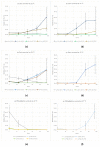Intracellular Behaviour of Three Legionella pneumophila Strains within Three Amoeba Strains, Including Willaertia magna C2c Maky
- PMID: 32041369
- PMCID: PMC7168187
- DOI: 10.3390/pathogens9020105
Intracellular Behaviour of Three Legionella pneumophila Strains within Three Amoeba Strains, Including Willaertia magna C2c Maky
Abstract
Legionella pneumophila is a facultative intracellular pathogen found in aquatic environments as planktonic cells within biofilms and as intracellular parasites of free-living amoebae such as Acanthamoeba castellanii. This pathogen bypasses the elimination mechanism to replicate within amoebae; however, not all amoeba species support the growth of L. pneumophila. Willaertia magna C2c Maky, a non-pathogenic amoeba, was previously demonstrated to possess the ability to eliminate the L. pneumophila strain Paris. Here, we study the intracellular behaviour of three L. pneumophila strains (Paris, Philadelphia, and Lens) within W. magna C2c Maky and compare this strain to A. castellanii and W. magna Z503, which are used as controls. We observe the intracellular growth of strain Lens within W. magna Z503 and A. castellanii at 22 °C and 37 °C. Strain Paris grows within A. castellanii at any temperature, while it only grows at 22 °C within W. magna Z503. Strain Philadelphia proliferates only within A. castellanii at 37 °C. Within W. magna C2c Maky, none of the three legionella strains exhibit intracellular growth. Additionally, the ability of W. magna C2c Maky to decrease the number of internalized L. pneumophila is confirmed. These results support the idea that W. magna C2c Maky possesses unique behaviour in regard to L. pneumophila strains.
Keywords: Legionella; biological biocide; cooling towers; free-living amoebae.
Conflict of interest statement
The authors declare no conflict of interest.
Figures





Similar articles
-
Mitigation of Expression of Virulence Genes in Legionella pneumophila Internalized in the Free-Living Amoeba Willaertia magna C2c Maky.Pathogens. 2020 Jun 5;9(6):447. doi: 10.3390/pathogens9060447. Pathogens. 2020. PMID: 32517040 Free PMC article.
-
Intracellular Behaviour of Legionella Non-pneumophila Strains within Three Amoeba Strains, Including Willaertia magna C2c Maky.Pathogens. 2021 Oct 19;10(10):1350. doi: 10.3390/pathogens10101350. Pathogens. 2021. PMID: 34684299 Free PMC article.
-
Free-living freshwater amoebae differ in their susceptibility to the pathogenic bacterium Legionella pneumophila.FEMS Microbiol Lett. 2009 Jan;290(1):10-7. doi: 10.1111/j.1574-6968.2008.01387.x. Epub 2008 Nov 10. FEMS Microbiol Lett. 2009. PMID: 19016880
-
From amoeba to macrophages: exploring the molecular mechanisms of Legionella pneumophila infection in both hosts.Curr Top Microbiol Immunol. 2013;376:1-34. doi: 10.1007/82_2013_351. Curr Top Microbiol Immunol. 2013. PMID: 23949285 Review.
-
Acanthamoeba and Dictyostelium as Cellular Models for Legionella Infection.Front Cell Infect Microbiol. 2018 Mar 2;8:61. doi: 10.3389/fcimb.2018.00061. eCollection 2018. Front Cell Infect Microbiol. 2018. PMID: 29552544 Free PMC article. Review.
Cited by
-
Proteomics and Lipidomics Investigations to Decipher the Behavior of Willaertia magna C2c Maky According to Different Culture Modes.Microorganisms. 2020 Nov 16;8(11):1791. doi: 10.3390/microorganisms8111791. Microorganisms. 2020. PMID: 33207645 Free PMC article.
-
Seasonal Host Shifts for Legionella Within an Industrial Water-Cooling System.Environ Microbiol Rep. 2025 Aug;17(4):e70132. doi: 10.1111/1758-2229.70132. Environ Microbiol Rep. 2025. PMID: 40583496 Free PMC article.
-
Editorial Comments to the Special Issue: "Legionella Contamination in Water Environment".Pathogens. 2020 Dec 2;9(12):1017. doi: 10.3390/pathogens9121017. Pathogens. 2020. PMID: 33276607 Free PMC article.
-
Insight into the Lifestyle of Amoeba Willaertia magna during Bioreactor Growth Using Transcriptomics and Proteomics.Microorganisms. 2020 May 21;8(5):771. doi: 10.3390/microorganisms8050771. Microorganisms. 2020. PMID: 32455615 Free PMC article.
-
Measurable genomic changes in Mycobacterium avium subsp. hominissuis after long-term adaptation in Acanthamoeba lenticulata and reduced persistence in macrophages.J Bacteriol. 2021 Mar 15;203(6):e00257-20. doi: 10.1128/JB.00257-20. Epub 2021 Jan 11. J Bacteriol. 2021. PMID: 33431432 Free PMC article.
References
-
- Kaufmann A.F., McDade J.E., Patton C.M., Bennett J.V., Skaliy P., Feeley J.C., Anderson D.C., Potter M.E., Newhouse V.F., Gregg M.B., et al. Pontiac Fever: Isolation of the etiologic agent (legionella pneumophila) and demonstration of its mode of transmission. Am. J. Epidemiol. 1981;114:337–347. doi: 10.1093/oxfordjournals.aje.a113200. - DOI - PubMed
-
- Benson R.F., Fields B.S. Classification of the genus Legionella. Semin. Respir. Infect. 1998;13:90–99. - PubMed
Grants and funding
LinkOut - more resources
Full Text Sources
Molecular Biology Databases

